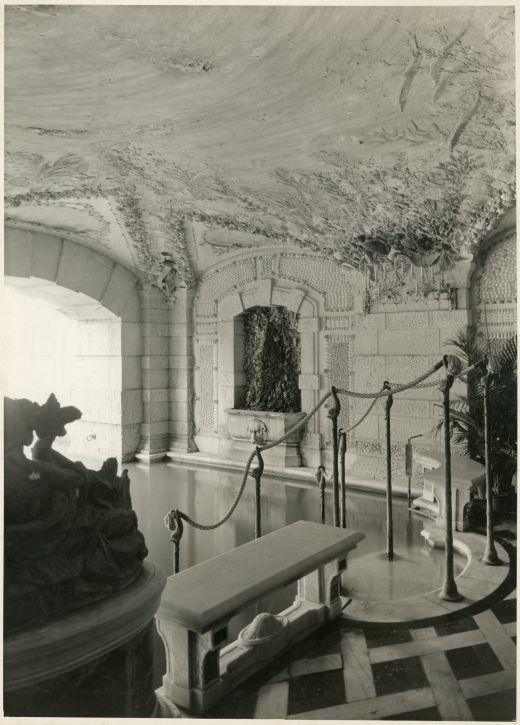
The Pool at Vizcaya. Historic Photograph by Frank Bell, 1935, Vizcaya Museum and Garden Archives
Though his painted plaster ceiling above Vizcaya’s indoor-outdoor pool grotto depicts many local flora and fauna, Chanler simultaneously subverts the idea of exoticism by adopting its language and wrapping it in a rather palatial style. The piece is often overlooked, partially as a result of its climate-induced state of deterioration, yet it exemplifies old South Florida’s high-society tastes and behaviors which have persisted in their tendency toward revivalism, emulation, and importation.
James Deering, who wintered at his Vizcaya estate, conceived of this property with the same ambitions as many other American industrialists comprising the first millionaire culture that emerged at the end of the 19th century. Property was meant to reflect the lifestyle they had earned, and to showcase the worldly items collected along the way. The rich intended to leave behind a personal legacy as well as reflect a culturally inherited one. In Deering’s case, such family wealth came from his father’s early investments in land in the western U.S. and subsequent investment in and ownership of agricultural machinery manufacturing, which ultimately made their land more valuable.
Borrowing from the classical motifs observed while traveling abroad, and feeling that the newly advanced America was the proper successor to the fortune and success of democracy, industry, ingenuity, and, well, ownership laid down by previous European countries, the affluent society members of this era created eclectic hodgepodges of status signifiers. They infused the story of the new America with Old World precedents.
Following other paradise-seeking industrialists such as Henry Flagler and his own family to South Florida, and hoping to find respite from a case of pernicious anemia, Deering arrived in Coconut Grove and began to plan his estate. He worked closely with prominent architects and designers, especially the artist Paul Chalfin, to create a revivalist wonderland that would house his collection and be a self-sustaining, opulent but livable village.
Alterations to existing tradition and history were liberally made to fit this endeavor—both in the design process and physically after artworks were acquired. A good example are the statues at the entry of the drive to the museum: Ponce de Leon and fictional explorer “Bel Vizcaya,” who was essentially fabricated by Deering and is a play on the Spanish merchant and alleged early explorer Vizcaino (who is also thought to be the namesake of the Spanish province Vizcaya and therefore Biscayne Bay).
Though he went to great lengths to collect an array of antiquities, and to mimic Italian, Spanish, and English architecture and landscaping, Deering was more inspired by myth than by European history. That this formal estate is situated in a sub-tropical context exemplifies a hybridized version of conspicuous leisure. Smaller, stranger ahistoric permutations of this vision still reverberate from Palm Beach to South Beach, and beyond, if you tune your eyes.
Recently the subject of a three-day symposium at Vizcaya, Robert Winthrop Chanler’s story as an artist runs parallel to the outwardly expressed status of Gilded Age proprietors. Like his patrons, he was no stranger himself to conspicuous leisure, a fact of which the presenters in the symposium made no small mention. Born into wealth, he reflected his surroundings: the elite milieu of collectors, singers, poets, and other characters of high society. Chanler straddled the bohemian and bourgeois; he was constantly forging his own wild and storied path. Like Vizcaya’s designer Paul Chalfin, he studied at the École des Beaux-Arts in Paris and was influenced by French artists that sought to put decorative art on equal footing with fine art. Like James Deering, he had his own “House of Fantasy” (the name of his New York City residence), albeit one more full of living exotic creatures.
The grotto ceiling at Vizcaya became the ultimate fantastical exposé—plaster sea creatures in high and low relief and metallic pigments on plaster make a environment imbued with the decadence of the era. Chanler was a decorative Modernist with a specific style who was planted and cultivated by the upper echelon that would ultimately commission and bolster his work. (Maybe he was a perfect reflection of themselves.) Using his social birthright as springboard, he finagled his way into being sheriff, threw impossibly hedonistic parties, and chased illustrious women. Chanler’s personal exploits, along with his life, legacy, and character were “big”—and this seems an irresistible explanation by those who study his work. It’s interesting, then, that the work is so ephemeral—even if largely a function of a mismatch of materials and climate. Perhaps his outlandish activities and flamboyant personality—fueled by position and means—fade less in the mind than the delicate pigments and materials he used on interiors. The harsh reality of the actual sea and its climate has muted Chanler’s colorful reflection, leaving scrambling conservators and curious scholars in its wake. His, then, is a big story: it is embedded in a much larger one of industry and the irreversible creation of an untouchable American upper class that has found its way into many different facets of art patronage. Big begets big begets bigger.
Cara Despain is a writer and artist who recently relocated from Salt Lake City to Miami.










